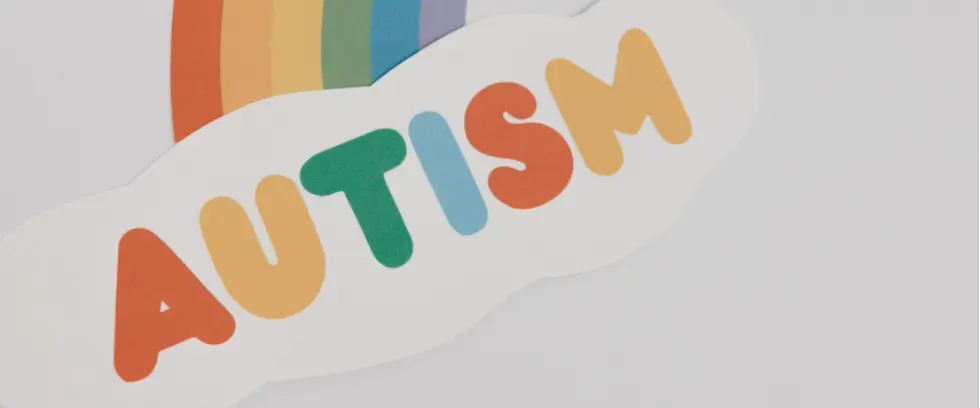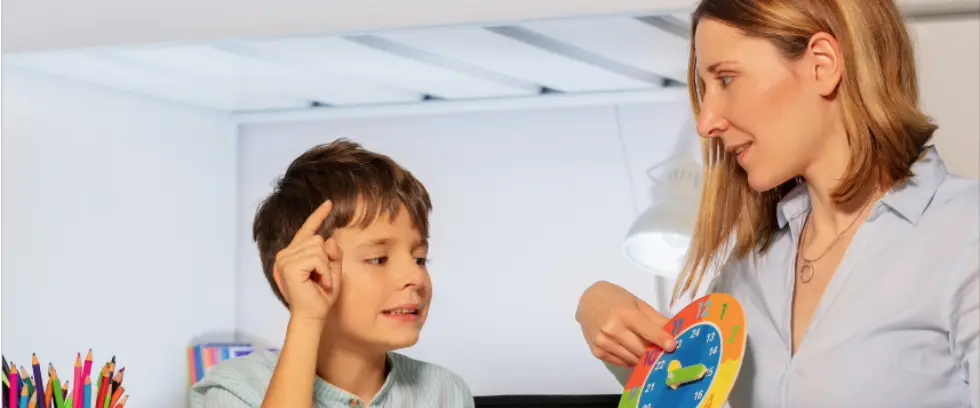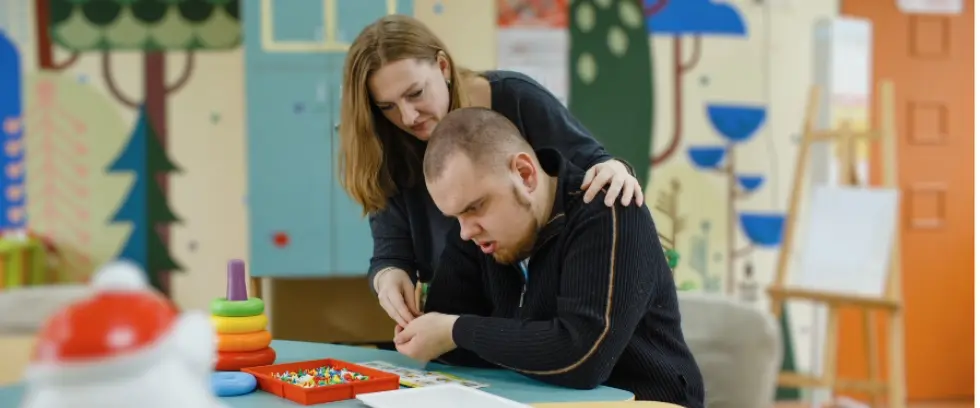Every child is unique and has their own developmental trajectory, but some behaviors may signal more than individual quirks. For young individuals in the U.S. with Autism, recognizing early signs is essential for unlocking support and understanding for their journey.
Autism Spectrum Disorder (ASD) is a developmental condition that affects communication, behavior, and social interaction. Early detection and intervention can significantly improve outcomes for children with ASD and provide helpful strategies for young adults with ASD.
Understanding Autism is a journey that starts with awareness. The disorder presents a spectrum of traits and strengths, and understanding early signs allows us to provide the best support for children and young adults with ASD.
In this article, we will look at ASD, early signs across developmental milestones, and discuss treatment and evaluation options for individuals who may show early signs of Autism.
Understanding Autism Spectrum Disorder
Autism is a developmental condition primarily affecting communication, social interaction, and behavior. It’s known as a ‘spectrum’ disorder because it includes a wide range of symptoms and severity levels, meaning each individual with ASD has a unique set of challenges and strengths.
Autism is usually evident in early childhood (typically in the first two years) and affects individuals throughout their lives. Early diagnosis and intervention are crucial in helping those with ASD develop to their full potential. These interventions can improve communication skills, social interactions, and reduce behavioral challenges to help individuals better navigate their environments.
While Autism is a lifelong condition, with the proper support and understanding, individuals can lead fulfilling lives. The degree to which individuals are impacted by their symptoms can vary widely, and many people with ASD have exceptional skills and talents because of their condition.
Overall, understanding Autism is not just about recognizing its challenges but also appreciating the unique perspectives and talents that these individuals bring to the world.
Recognizing Autism Symptoms and Strengths
The first step to understanding ASD is to identify the symptoms and strengths of individuals on the spectrum. ASD symptoms manifest in various ways that affect communication, social interactions, and behavior.
Specifically, according to the DSM-V, individuals must exhibit deficits in
- Social reciprocity (empathy and understanding)
- Nonverbal communication (eye contact and body cues)
- Developing and maintaining relationships.
Individuals with Autism may find it challenging to interpret social cues such as body language or facial expressions alongside verbal cues, often taking words at ‘face value.’ they might struggle with forming and maintaining relationships and prefer solitary activities, but also form deep bonds with those they are close to and can be extremely loyal.
Many with ASD also struggle with verbal and non-verbal communication. They might have delayed speech development and difficulty interpreting non-verbal cues such as hand gestures or eye movements.
Additionally, individuals with ASD show restricted and repetitive patterns of behavior; these can manifest as:
- Repetitive movements or speech patterns
- Insistence on repetitive routines or rituals
- Fixation and intense focus on specific interests or topics
- Either intense reaction to or lack of reaction from sensory inputs, such as sounds or visual stimulation.
Restrictive behavior refers to both verbal and non-verbal behavior. Typical behaviors may include hand-flapping, rocking, lining up objects, or repeating specific phrases and words. These activities can provide comfort and predictability for individuals with Autism.
While recognizing these challenges is crucial, it’s also essential to recognize the unique strengths and abilities of individuals with ASD. Many individuals have exceptional skills in memory, attention to detail, art, music, and mathematics. Because of their heightened interest in niche topics, individuals with ASD often have remarkable knowledge and expertise in specific areas.
Understanding the unique challenges and strengths of Autism allows us to provide the appropriate support for those we love, helping them to thrive in their personal and professional lives.
Early Signs of Autism Across Developmental Milestones
Autism presents a range of signs and symptoms at various stages of development. These indicators evolve differently from infancy to young adulthood, impacting communication, social interactions, and behavior.
Autism in Infants
Autism can manifest as early as 6-9 months and is most apparent by two years of age. By this time, individuals with ASD will have had difficulty engaging in verbal and non-verbal communication. Common challenges include:
- Difficulty maintaining eye contact
- Difficulty mirroring facial expressions and vocalizations
- Delayed speech milestones
- Abnormal responses to sights, sounds, and other stimuli
- Lack of orientation towards voices and lack of recognition of others, or their own names
- Lack of interest in socializing with other children
It’s important to recognize that developmental milestones are guides only, and wide variations in development can occur across individuals. Being delayed in speech or eye contact alone does not indicate a sign of Autism.
Typically, individuals with ASD will show multiple symptoms, including both repetitive movements and limitations in socialization.
Additionally, individuals with ASD will have more pronounced symptoms as they get older, especially by the time they can talk and socialize with others. For individuals not on the spectrum, the above mentioned issues may appear as delays, but they are no longer challenging after further development.
Autism in Children
As children grow, signs of ASD become more apparent, including difficulties with social interactions, challenges in developing friendships, and repetitive behaviors.
Overall, Autism in children presents differences from developmental milestones in several areas:
- Social Interaction: Children with Autism may show less interest in playing or talking to others, difficulty making friends, or not show interest in imaginative play.
- Communication: Delayed speech development is common, and even when language skills are strong, there are usually difficulties in using language in a social setting.
- Repetitive Behaviors: Children will demonstrate repetitive behaviors or have strong routines.
- Focused Interests: Children with ASD may develop intense interests in specific topics, outside the general interests of most children.
These symptoms typically become much more pronounced when children begin formal education. While their education may highlight specific symptoms and strengths, such as an intense focus on a particular topic, the socialization provided at school will provide the most feedback for symptoms.
Autism in Young Adults
Autism will continue to present unique challenges into young adulthood. While repetitive behaviors persist, young adults with ASD will struggle to understand complex social cues and maintain conversations.
The period of young adulthood for most individuals involves learning and understanding complex and nuanced social cues to navigate interpersonal situations (e.g., practicing and preparing for an interview; understanding implied ‘rules’ of a social group) and personal relationships (e.g., professing feelings for a romantic partner, picking up on sarcasm or dry humor).
Additionally, young adults are on the trajectory to independence and often demonstrate an intense need to be self-sufficient. Conversely, individuals with ASD may struggle with independence or adjusting to situations where there isn’t consistency and control.
For each stage, parental guidance and observation are crucial in recognizing the early signs of Autism. Recognizing these signs can lead to an appropriate diagnosis and intervention, helping children and young adults navigate challenges while highlighting their unique strengths and interests.
The Importance of a Professional Autism Diagnosis
A correct Autism diagnosis for individuals with ASD is imperative for accurately identifying the presence of Autism and distinguishing it from other developmental conditions. This diagnosis is key to unlocking tailored support and opens access to various educational, therapeutic, and financial resources.
For parents and family members, a professional diagnosis provides clarity and understanding while allowing for long-term planning, helping to map out educational paths, career options, and essential strategies for individuals with Autism.
What Does an Autism Evaluation Involve?
Determining an Autism diagnosis occurs by a healthcare professional evaluating symptoms, in this case for both social impairments and repetitive or restrictive movements. This evaluation involves several strategies to understand the individual’s developmental history, how they respond to social situations, speech/language cues, and medical assessments.
Additionally, Autism evaluations typically involve follow-up visits to measure progress and assess next steps with additional resources for parents and caretakers to consider before a follow-up appointment.
It’s important to understand that reliable Autism evaluations are not just questionnaires, virtual appointments, or single interviews. These methods, while quick and cheap, fail to recognize the diverse symptoms of Autism, an individual’s unique developmental trajectory, and the observation required to make an objective diagnosis.
Online or standalone Autism evaluations are also not usually performed or moderated by a medical professional trained in recognizing and evaluating developmental cues, leading to improper diagnostics and support for individuals in need.
When Should I Seek Professional Help
According to the Center for Disease Control, a reliable diagnosis is possible by 18-24 months. Signs can show up earlier, but the developmental traits associated with ASD become more pronounced by this age.
Individuals can receive a diagnosis at any age after two, and most diagnoses are made after this age. However, recognizing the symptoms as early as possible is the first step towards a correct diagnosis.
For parents and caretakers who are concerned that their child may have a developmental disorder such as Autism, you can pay attention to developmental delays, unusual repetitive behaviors, and social communication challenges.
This process is known as developmental monitoring and is an ongoing process by those closest to the individual that focuses on awareness of that child’s development.
If you’re concerned about your child’s developmental progress, the American Academy of Pediatrics recommends ASD evaluations at 18 and 24 months of age to assess their developmental progress.
Therapeutic Strategies for Managing Autism
For individuals with Autism, the best strategies to manage symptoms and provide resources for them to reach their full potential involve therapy and, in some cases, medication.
One of the most effective options is Applied Behavioral Analysis due to its structured and reinforcement-based approach, which is particularly beneficial in modifying behaviors and learning skills.
Additionally, Occupational Therapy and Speech and Language Therapy are effective for improving quality of life. Occupational Therapy focuses on improving motor skills and daily living, while Speech Therapy addresses and enhances communication skills.
The goal of these therapeutic strategies is not only to help manage symptoms but also to provide context for those symptoms, improve quality of life, and recognize each individual’s unique strengths.
Applied Behavioral Therapy
Applied Behavioral Analysis (ABA) focuses on improving specific behaviors, such as social and learning skills, through reinforcement strategies. In ABA, individuals learn what causes behaviors, how the behaviors manifest, and the consequences of those behaviors.
Through ABA, individuals can modify behaviors, focusing on increasing positive behaviors and reducing negative ones through rewards and consequences, emphasizing positive reinforcement. ABA is distinct for its individualized approach, where therapy strategies are customized based on the person’s unique needs and strengths.
While ABA is most commonly used with children, its benefits are applicable across all ages, making it an essential tool in enhancing the quality of life for individuals with ASD.
Occupational Therapy
Occupational Therapy (OT) plays a crucial role in assisting individuals with ASD to develop skills necessary for everyday living. OT focuses on enhancing sensory processing, fine motor skills, and self-care.
Many individuals with ASD have sensory processing issues, which can either be overwhelming for individuals who are overly sensitive or concerning when individuals fail to recognize environmental cues from a lack of sensory information. Occupational therapists help individuals manage these sensitivities, helping them cope with their environment.
Additionally, Occupational Therapists can assist with improving fine motor skills, coordination, and daily tasks to improve independence and daily functioning. The goal is not just about addressing physical skills but about assisting individuals to participate fully in their daily lives.
Speech and Language Therapy
Speech and Language Therapy addresses one of the core challenges in ASD: communication. By improving both verbal and non-verbal communication skills, this therapy plays a significant role in helping individuals express themselves more effectively and understand others.
In Speech Therapy, individuals work to enhance communication skills, focusing not only on the ability to speak but also on understanding and processing language. This therapy covers a wide range of techniques, from basic articulation exercises to more complex language and conversation skills.
One of the most effective options is cognitive behavioral therapy to help manage challenging behaviors and emotions, improve socialization skills, and manage repetitive movements.
Additionally, Family Therapy and medication are optional but powerful strategies to help specific individuals achieve a higher quality of life and feel more comfortable engaging in social situations.
The goal of these therapeutic strategies is not only to help manage symptoms but also to provide context for those symptoms, improve quality of life, and recognize each individual’s unique strengths.
Cognitive Behavioral Therapy
Cognitive Behavioral Therapy (CBT) is a structured, goal-oriented therapy that identifies and modifies negative thought patterns and behaviors. It aims to help individuals understand the connection between their thoughts, feelings, and behaviors while developing strategies to cope with challenging situations.
CBT is particularly effective in addressing co-occurring issues such as anxiety, depression, and emotional difficulties that individuals with ASD face. Through CBT, individuals with Autism can learn coping skills to manage stress, improve social interactions, and handle sensory responsiveness.
Family Therapy
Family Therapy for ASD plays a vital role in supporting both individuals with Autism and their families. This approach acknowledges the impact of Autism on family dynamics. It provides a platform for family members to understand the challenges and needs associated with ASD.
In these sessions, family members learn effective communication strategies, ways to handle behavioral challenges, and how to support one another. These strategies help build a nurturing environment crucial for the well-being of individuals with Autism.
Optional Medication
For individuals with Autism, there are no official medications recommended to treat the condition. However, medication is an optional treatment to help manage the associated symptoms of ASD and improve overall quality of life.
Medications may target symptoms such as anxiety, depression, hyperactivity, and attention difficulties. In each case, the use of medication is highly individualized, depending on the specific needs and quality of life of the individual with ASD.
Additionally, medication should always be a part of therapy, not a replacement for it, as it helps individuals work through challenges presented and worked on in therapy.
Get the Support and Treatment You Deserve With Start My Wellness
For parents and caretakers, understanding our children and their unique developmental trajectories is essential. Observation and care go hand in hand to ensure the best possible support for our loved ones.
When children have development issues, understanding the reason is crucial to providing that support, and for children with ASD, it’s essential for getting appropriate treatment.
At Start My Wellness, we believe it’s never too early to start your mental health journey and get the support you or your family needs. Our team of dedicated mental health professionals specializes in a range of services tailored to the unique needs of this with ASD. This includes those seeking a late diagnosis of autism who may suspect the condition but have never been formally evaluated.
For anyone in the Michigan area seeking support, understanding, and professional guidance in managing Autism for themselves or a loved one, Start My Wellness is here for you. Reach out to Start My Wellness today at 248-514-4955 to begin your transformative journey.
Sources
- National Institute of Mental Health: Autism Spectrum Disorder
- CDC: Diagnostic Criteria for Autism Spectrum Disorder
- Autistica: Focus on Strengths as Well as Challenges
- National Library of Medicine: Autism in Infants
- Autism SA: Autism First Signs
- Start My Wellness: Is it Autism or Am I Just Quirky?
- NHS: Signs of Autism in Adults
- Start My Wellness: 10 Warning Signs of a Bad Autism Evaluation
- CDC: Screening and Diagnosis of Autism Spectrum Disorder
- American Academy of Pediatrics: Developmental Surveillance and Screening
- Autism Speaks: Applied Behavioral Analysis
- National Autistic Society: Why is Occupational Therapy Important for Autistic Children
- National Institute of Health: Speech-Language Therapy for Autism
- National Institute of Health: Medication Treatment for Autism
- Start My Wellness: Therapists

Author: Anton Babushkin, PhD
Looking for a Therapist? Start My Wellness has highly experienced Licensed Therapists that are currently accepting new patients.





